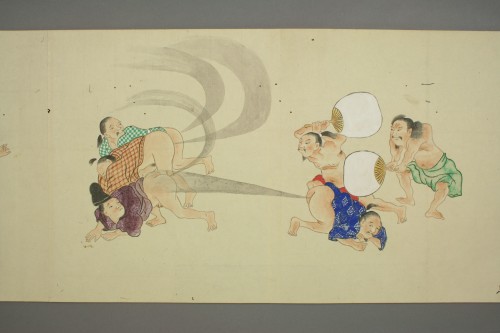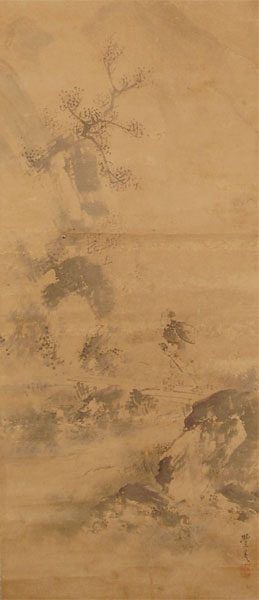Perhaps you’ve been so lucky never to have prayed into a horse’s ear (uma no mimi ni nenbutsu), but I bet someone has once looked at you with white eyes (shiroi me de miru) until you felt like your stomach was boiling (hara ga nie-kurikaeru yō).
Yes, those are Japanese Idioms. I’ve had a class about them last semester, so I thought I‘ll share my acquired wisdom with you ;). As with everything Japanese, they come in a couple of different categories. And like in any language, mostly you can’t quite guess what they’re supposed to mean. So, I’ll first talk about the different types and then I’ll tell you why I think, all in all, they are worth the bother of learning them. In the process I’ll introduce you to some interesting ones, anime examples included.
What are Japanese idioms?
The most commonplace word for idioms is kotowaza, which I like because it sounds like ‘word-skill’, and that is exactly what the person listening to you will think you have if you can use some idioms appropriately. The more technical term would be kanyōku (phraseme), but for non-university contexts, I guess that’s a ‘snake-leg’ (dasoku) type of fact – pretty much superfluous. An idiom can be a whole sentence, making it essentially a quotation, though in many cases the source is lost,[i] or it can be a compound of words which functions as a part of speech, and that’s how most of them work.
So, you can have idiomatic compounds to use as nouns, adjectives and adverbs or verbs. What makes them idiomatic is that fascinating/annoying ability they have, as
I mentioned above, to mean something else or something more than what the individual words mean. Sometimes you can guess at the meaning based on the images used (that would be idioms based on a simile) but often enough you can’t (when the idiom metaphorical, or when refers to a historic or fictional context unknown to you).
So, read the first paragraph again. The last one might be easiest to guess, but perhaps I just feel like that because there is a very
similar idiom in my first language. If your stomach is boiling over, that means you’re seething with fury. And you might have seen a depiction of ‘looking at someone with white eyes’ in an anime – it means looking at someone as if you didn’t know them, mostly out of disdain.

The first one, a prayer in a horse’s ear, is one of my favourite Japanese idioms. It’s just such a funny image and it perfectly conveys that sense of futility which grabs you when you try to persuade someone, knowing it won’t work.[iii] This one also has some cultural flavour; a nenbutsu is an invocation of Amida Buddha. According to the Jōdo Shinshū sect of Japanese Buddhism, trusting in that invocation alone can assure your salvation by Amida Buddha after your death. So as I see it, the nenbutsu is kind of the cup-ramen of religious practices. The horse still won’t benefit from it though, making it the prime example of good intentions wasted.
The heavy stuff: 4-character-idioms
Back to the types of idioms: There is one pretty tricky category call yoji-jukugo, idioms consisting of 4 kanji characters, which are usually quotations (often titles) of ancient Chinese fables and moral tales. For example, there’s koketsu-koji, ‘Tiger’s den, tiger cub”: if you don’t enter the tiger’s den, you won’t get its cub. The story goes that a Chinese diplomat was sent as an envoy to the court of another king. He was treated favourably, but only for a short time, since that king was also offered an alliance with the Huns. As a reaction to the slight, the Chinese diplomat called his men, said these words, and they went to murder the entire Hun delegation, resulting in the king accepting the alliance – most probably because he was worried about his own head. So koketsu-koji means you need to undergo risks to achieve something, particularly in order to best your competitors.

Something you might hear student say during revision time is shiku haku, ‘4 sufferings, 8 sufferings’, an allusion to the Buddhist concept of ku. Such suffering is: being apart from loved ones, being among people you hate, not getting what you want, and physical illness – sounds like a day in the overcrowded library a week before exams/essay deadlines, doesn’t it? Not all yoji-jukugo are based on Chinese culture, however. Isseki, nichō is a literal translation of ‘[killing] two birds with one stone’, and it means the exact same thing.
Idiomatic wildlife
Let’s stick with the animals for a moment. As in Europe, animals have been given certain character trains in their folkloristic appearances. Horses feature as typical gregarious animals, since sheep did not play much of a role in old Japan. Thus, ‘if one horse goes crazy, a thousand horses go crazy’ (ippiki no uma ga kurueba senhiki no uma mo kuruu). As in a sudden stampede, crowds of people tend to follow the rest. Cats are greedy – ‘giving gold to a cat’ (neko ni koban) is the Japanese version of ‘pearls before swine’ – and foxes are tricksters, capable of transforming into humans and bewitching people. ‘Being pinched by a fox’ (kitsune ni tsumareru) means being disbelieving one’s eyes, because the situation feels like surreal, like a fox had put a spell on you. Speaking of foxes, the Japanese term for sunshower is kitsune no yomeiri, ‘the foxes’ bridal procession’, because it is said that foxes enjoy this kind of weather. And who wouldn’t like to see a bridal procession of magic foxes?
The kirin (not the beer, and not a giraffe either, but a mystical creature best described as a dragon unicorn) represents grace, so if ‘even a unicorn stumbles’ (kirin no tsumazuki) that means we all make mistakes. Monkeys are clever (at least in some of the stories) and try to solve problems, whereas dogs tend to attempt a violent solution, therefore they are mortal enemies; consequently, if two people absolutely cannot stand one another, they have ‘a relationship like dogs and monkeys’ (ken’en no naka).
Usage and adaptation
Two more examples, both with anime references, rejoice! Once, the idiom chimimōryō ga habikōru came up in a text on Japanese companies’ troubles in India. I could not only suggest ‘all hell 
Also, if you’ve watched or read Rurōni Kenshin, you’ll probably know another 4-kanji-idiom (yoji-jukugo). Remember Sōjiro, the cute boy assassin who managed to break Kenshin’s first Reverse-Bladed Sword, and how he never shut up about ‘If you’re strong, you live, if you’re weak, you die’? That’s basically jakuniku kyōshoku, ‘the weak are the meat the strong devour’. I’ve seen that translated as ‘survival of the fittest’, but first, ‘fit’ doesn’t mean strong and second, the idiom has this sense of the strong preying on the weak, and remaining strong because of this injustice, which seems lacking in the Darwinian phrase.
Anime also lends itself to visual puns and depictions of idioms (or people misunderstanding them). Unfortunately, I cannot think of even a single example of this, possibly because I hardly ever watch slice-of-life and High School comedy anime, which I assume are the most fertile ground for such visual puns. If anyone reading this knows of an example, feel free to share it in the comments!
Translation issues
As with all cultural references, idioms are notoriously difficult to translate. Do you take the closest English equivalent, if there is one, and loose the ‘Japanese/Chinese flavour’ in the process? Do you keep it literal and hope that the reader can guess at the meaning from context? Do you provide a footnote (or headnote in case of anime subtitles)? My own preference is a mixture of the first and second approach. I would try to find a similar English idiom and tweak it a little, so that a bit of the original wording and context is transmitted as well. For example, there is the yoji-jukugo ‘the fox borrows the tiger’s authority’ (koka-ko’i or kitsune, tora no i wo karu). According to the Chinese story this is based on, the tiger was devouring all kinds of animals, until he one day caught the fox, who said to him: “Don’t you dare eat me, for the Heavenly Father has made me master of all animals. If you don’t believe me, just follow behind me and observe. The animals will see me and flee.” The tiger believed him and did as he was told, walking behind the fox. The animals saw the two of them and fled. But tiger, not knowing they were running away from him, thought they feared the fox. (From the sengoku-saku/Zhan Guo Ce, written in the second century BC and detailing the history of the Chinese Warring States Period (5-3rd century BC).) So, the idiom refers to people who borrow the power or authority of others in order to boss people around.[ii] Now, as a translation I would suggest ‚a fox in a tiger’s skin‘, because like the ‚wolf in a sheep’s skin‘, the fox assumes the airs of a different type of folkloristic animal in order to deceive others. A reader, I think, will be able to infer that, since a tiger is much grander and more dangerous than a fox, the fox is doing this to appear greater than he is, and voila – the story has been brought across.
To sum up: idioms are examples of a ‘living’ language. They are transmitted over the centuries but still applied in modern contexts, even anime, and sometimes they change: the phrase kamonegi is an abbreviated version of kamo ga negi wo seotte kuru, ‘the duck arrives already carrying spring onions’ (to season it with), which is a way of saying you received something good without working for it. However, Japanese exchange students stressed that they knew the abbreviated version much better. In this way, idioms are one of the aspects which make a language vivid and interesting; but you wouldn’t want to misuse them. So, my recommendation to language learners is to pick up a choice few you find interesting, for future use. And if you come across one in the future, try to find out what it means: there might be a nice story behind it.
I close this edition of my Musings with many thanks and to my Japanese grammar teacher and my classmates!
Notes and references:
English-Japanese idiom lists:: http://matadornetwork.com/abroad/30-awesome-japanese-idioms-start-using-english/; http://www.linguanaut.com/japanese_sayings.htm
[i] If there is a source, you would call it an aphorism. English has a lot of ‚idioms‘ which are actually quotations from Shakespeare, for example.
[ii] http://sanabo.com/words/archives/2002/09/post_2904.html





Thanks for the information.
We’re glad you found it useful!
Well,,, you screwed the pooch on that one. Not just in English, but in Japanese too. For one thing, you sure and hell didn’t share any kind of wisdom. You did, however, share some knowledge. Albeit, FALSE knowledge. For one thin, the common word for idiom in Japanese IS NOT “kotowaza,” but KIMARI-MONKU. Kotowaza is proverb.
Good morning!
Firstly, thanks for reading and commenting. I am sorry I diappointed you; the line about wisdom was a joke but perhaps I didn’t make that clear enough.
Regarding the term ‘kotowaza’, I checked my dictionaries and yes, you are correct, it is usually translated as ‘proverb’, not ‘idiom’. (e.g. Progessive Wa-ei Chûjiten) However, since proverbs are a subclass of idiomatic expressions (as explained here: http://www.learnersdictionary.com/qa/what-s-the-difference-between-idioms-and-proverbs), I wouldn’t say what I wrote was wrong, just somewhat impecise. The reason for that, as I stated above, is that I thought it might be useful for the average Japanese learner to know the term kotowaza, because you can count on any Japanese speaker to know what you mean; whereas the technical term ‘kanyôku’ seems a bit too specific to me to be useful in general conversation.
Now, I researched the term you suggested, kimari-monku, and thanks for mentioning that because now I’ve learned something new! However, based on the definitions and examples I found online, a kimari-monku seems to be more of a stock phrase, with a degree of idiomaticity lower, not higher, than a proverb. (e.g. http://gogakuru.com/english/phrase/tag_cloud/1577_%E6%B1%BA%E3%81%BE%E3%82%8A%E6%96%87%E5%8F%A5.html) And while that’s interesting, it’s not what I was talking about in my article. As I said, the ‘proper’ term for idiom (or phraseologism, if you prefer the more technical term) I learned was kanyôku 慣用句, and I’d say both kotowaza and kimari-monku are sub-categories of that.